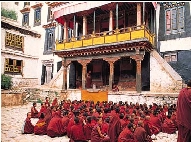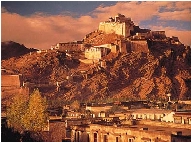|
 Lhasa,
capital of the Tibet
Autonomous Region,
covers an area of 544
square kilometers and is
"The Land of Gods" in
Tibetan, sits on the
north bank of River
Lhasa, a tributary of
the Yarlung Tsangbo
River, at an altitude of
3,700 meters. It has a
history of over 13
centuries. With more
than 3,000 hours of
sunshine annually, Lhasa
is famed as " the City
of Sunshine". It is the
capital of Tibet
Autonomous Region and
the center of Tibet’s
political, economic,
cultural and religious
activities. There are
many historic sites and
famous relics in the
city proper and its
suburbs, among which the
Potala Palace, Jokhang
Temple, Drepung
Monastery, Sera
Monastery and Gandan
Monastery are world
famous. Lhasa,
capital of the Tibet
Autonomous Region,
covers an area of 544
square kilometers and is
"The Land of Gods" in
Tibetan, sits on the
north bank of River
Lhasa, a tributary of
the Yarlung Tsangbo
River, at an altitude of
3,700 meters. It has a
history of over 13
centuries. With more
than 3,000 hours of
sunshine annually, Lhasa
is famed as " the City
of Sunshine". It is the
capital of Tibet
Autonomous Region and
the center of Tibet’s
political, economic,
cultural and religious
activities. There are
many historic sites and
famous relics in the
city proper and its
suburbs, among which the
Potala Palace, Jokhang
Temple, Drepung
Monastery, Sera
Monastery and Gandan
Monastery are world
famous.
Before the mid-seventh
century when Lhasa,
later a central town of
Tibetan region, was yet
to come into being, the
area called Wotang was a
marshy land of wildness,
frequented by antelopes.
On one bright summer
day, Songtsan Gampo,
leader of the Tubo tribe
that had risen to power
in the Yarlung River
Valley, was struck by
the perilous position of
an a rea
flanked by two steep
mountains, while bathing
in the Lhasa River, and
decided that this was to
be the home of his
kingdom. This ambitious
Tibetan king moved the
center of his rule to
Wotang and ordered the
construction of his
residence on the hilltop
of Potala. In 641 A.D.,
Songtsan Gampo who by
this time had conquered
the whole Tibetan region
wedded Princess Wencheng
of the Imperial Tang
Court. When the princess
arrived, she became
convinced that Lake
Wotang was a devil’s
heart to be overpowered
by the construction of a
grand temple after
filling up the lake with
earth. The princess
further suggested that
the earth be carried by
white goats. This
imposing grand temple
became a symbol of the
kingdom. The temple,
later known as Jokhang,
was initially named
Lhasa, "the Sacred Land"
in Tibetan. Over the
centuries, Lhasa became
a political and
religious center of
Tibet. Administrative
orders were issued from
the myriad of imposing
palaces; the great
temples and monasteries
were home to omnipotent
liturgical establishment
and witnessed the rise
of many religious
leaders and endless
religious ceremonies.
The faithful composed
the population of the
town and Lhasa became a
true "Mecca" of Tibet. rea
flanked by two steep
mountains, while bathing
in the Lhasa River, and
decided that this was to
be the home of his
kingdom. This ambitious
Tibetan king moved the
center of his rule to
Wotang and ordered the
construction of his
residence on the hilltop
of Potala. In 641 A.D.,
Songtsan Gampo who by
this time had conquered
the whole Tibetan region
wedded Princess Wencheng
of the Imperial Tang
Court. When the princess
arrived, she became
convinced that Lake
Wotang was a devil’s
heart to be overpowered
by the construction of a
grand temple after
filling up the lake with
earth. The princess
further suggested that
the earth be carried by
white goats. This
imposing grand temple
became a symbol of the
kingdom. The temple,
later known as Jokhang,
was initially named
Lhasa, "the Sacred Land"
in Tibetan. Over the
centuries, Lhasa became
a political and
religious center of
Tibet. Administrative
orders were issued from
the myriad of imposing
palaces; the great
temples and monasteries
were home to omnipotent
liturgical establishment
and witnessed the rise
of many religious
leaders and endless
religious ceremonies.
The faithful composed
the population of the
town and Lhasa became a
true "Mecca" of Tibet. |